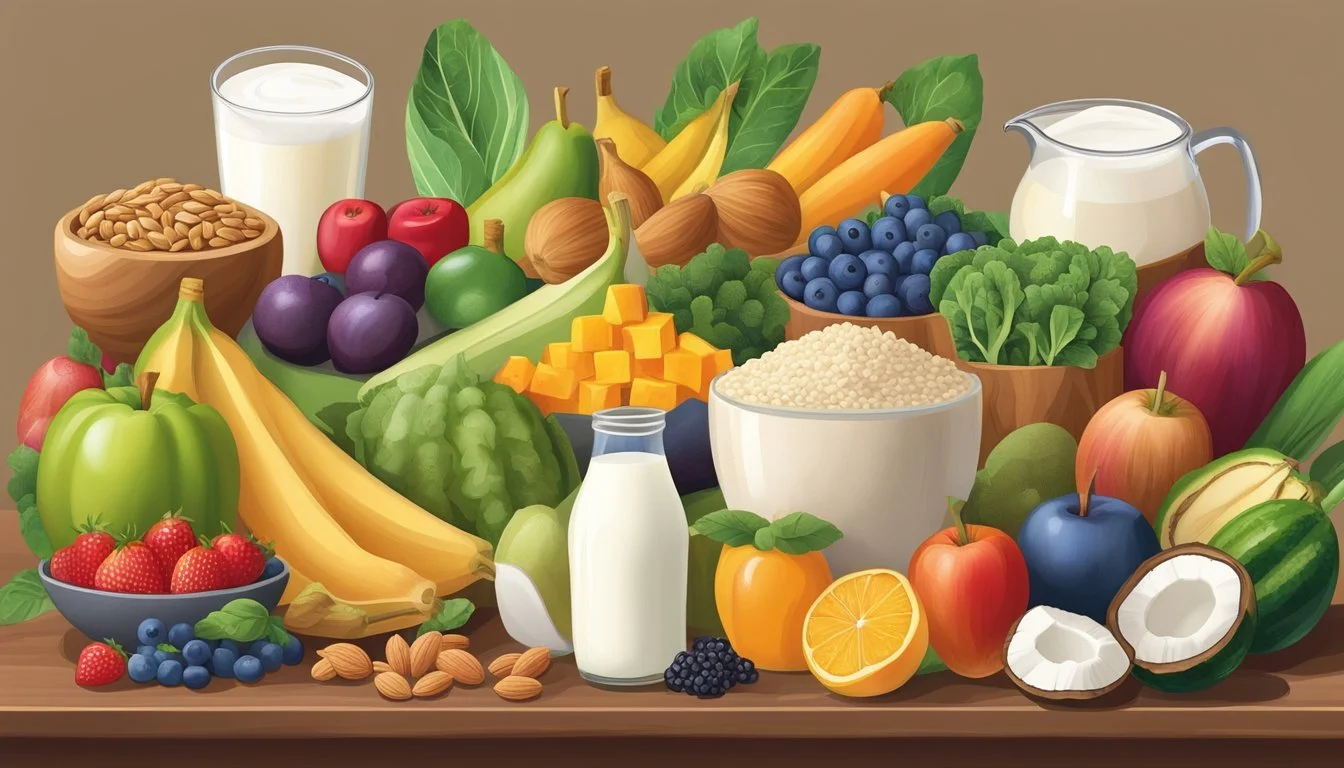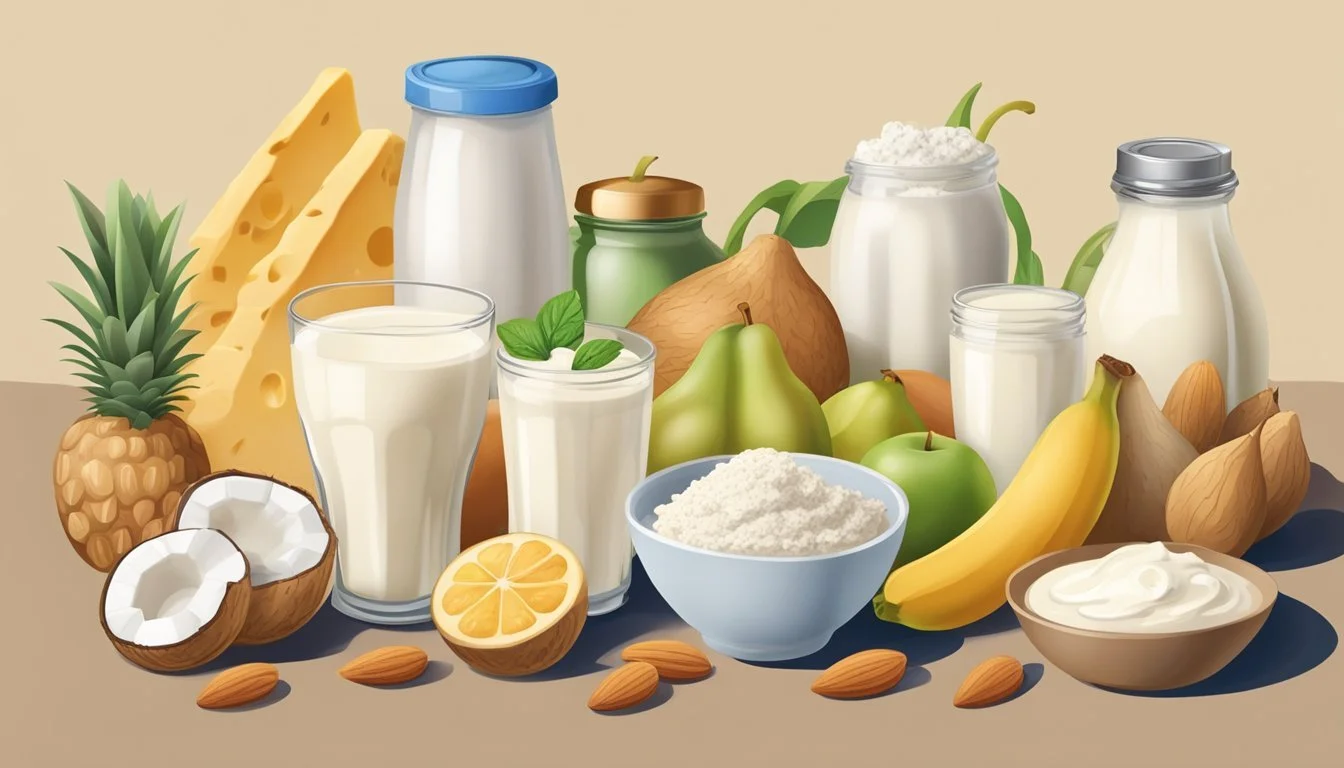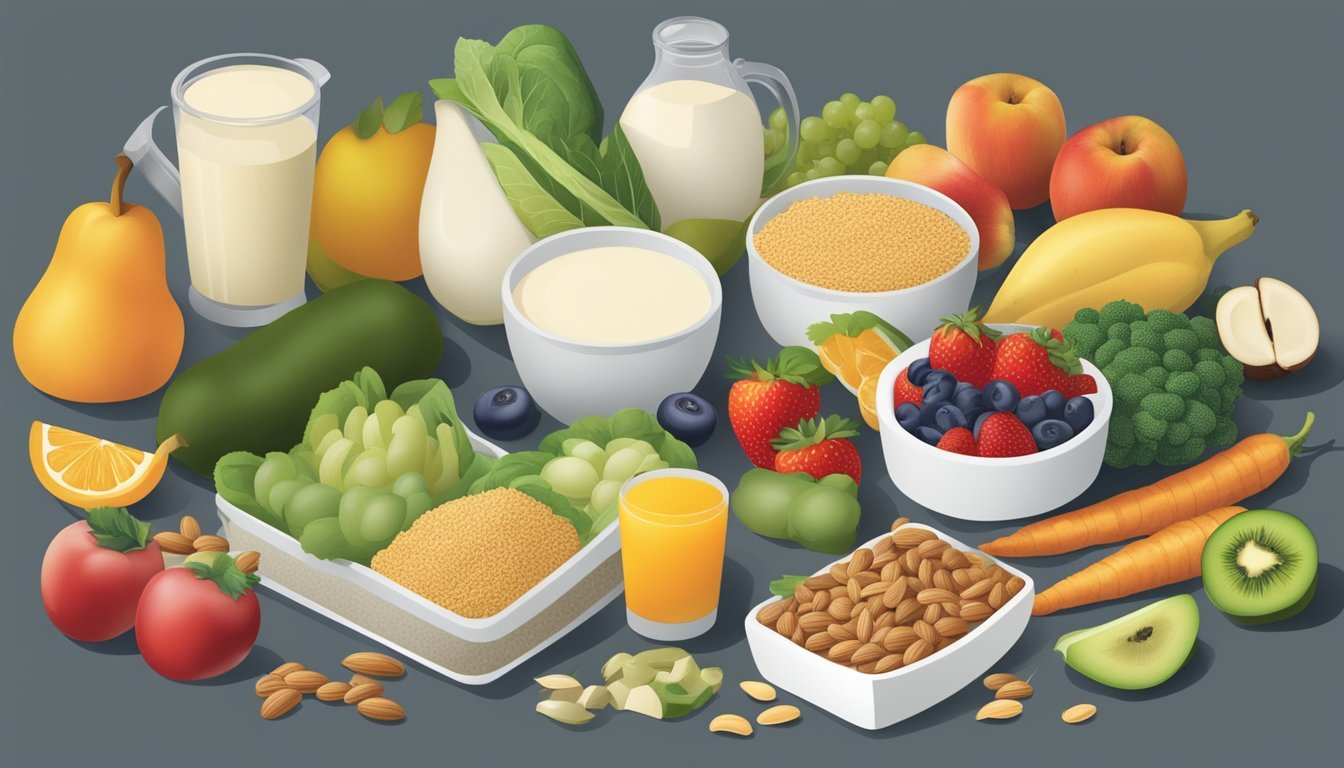Best Foods for a Dairy-Free Diet
Optimal Nutrition Without Dairy Products
Adopting a dairy-free diet involves eliminating all dairy products from one's nutritional plan. This includes avoiding foods such as cow's milk, cheese, yogurt, and ice cream, which are traditional sources of nutrients like calcium, protein, and vitamin D. Individuals may choose a dairy-free lifestyle for various reasons, including lactose intolerance, milk allergies, ethical preferences, or health considerations such as reducing inflammation or skincare.
To maintain a balanced diet while foregoing dairy, individuals can seek out alternative sources of the aforementioned nutrients. Plant-based milk substitutes, such as almond, soy, oat, and coconut milk, are readily available and often fortified with calcium and vitamin D. Proteins can be obtained from non-dairy sources like legumes, nuts, seeds, and whole grains, which provide the necessary amino acids that the body requires.
A dairy-free diet does not have to be limiting; instead, it can be rich and diverse. Consumers should be vigilant when selecting processed foods and look for labels indicating "dairy-free" or "nondairy." However, it is crucial to read ingredient lists carefully, as some products may still contain dairy-derived components. With a thoughtful approach, those on a dairy-free diet can enjoy a variety of tasty and nutritious foods while adhering to their dietary restrictions.
Understanding Dairy Allergies and Lactose Intolerance
Dairy allergies and lactose intolerance both involve reactions to dairy, but they spring from different bodily mechanisms. This section clarifies these differences and discusses the symptoms associated with each condition.
Distinguishing Between Dairy Allergy and Lactose Intolerance
Dairy Allergy is an immune system reaction to proteins found in cow's milk and other dairy products. When someone with a dairy allergy consumes dairy, their body mistakenly treats it as a harmful invader, triggering an allergic reaction that can range from mild to life-threatening.
In contrast, Lactose Intolerance is a digestive issue where the body lacks enough lactase, the enzyme required to break down lactose, which is the sugar in milk. Consuming dairy leads to undigested lactose in the digestive system, causing uncomfortable symptoms.
Symptoms of Dairy-Related Health Issues
Dairy Allergy:
Symptoms of a dairy allergy may occur immediately or within hours and can include:
Hives or a rash
Swelling of the lips, throat, or tongue
Wheezing or difficulty breathing
Abdominal pain
Vomiting
Lactose Intolerance:
Common symptoms of lactose intolerance typically emerge hours after consuming dairy and often consist of digestive discomfort such as:
Bloating
Gas
Diarrhea
Abdominal pain
Symptoms can vary in severity with both conditions and may depend on the amount of dairy consumed. It is crucial for individuals who suspect they have a dairy allergy or lactose intolerance to consult with a healthcare provider for accurate diagnosis and management.
Fundamentals of Dairy-Free Diet
Embarking on a dairy-free diet requires understanding both the health implications and the nutritional adjustments necessary to maintain well-rounded well-being. This section will guide readers through the health benefits and nutritional considerations required for a successful dairy-free lifestyle.
Health Benefits of a Dairy-Free Diet
Individuals often experience positive health outcomes when replacing dairy with alternative food sources. Many report reduced inflammation and improvements in digestive discomfort, particularly those with lactose intolerance. Additionally, some may notice weight loss, as they eliminate high-fat dairy products. A dairy-free diet also eliminates the risk of exposure to allergic reactions for those with a milk allergy.
Nutritional Considerations and Alternatives
When one eliminates dairy from their diet, it is crucial to seek out nutrient-rich alternatives to ensure intake of essential nutrients found in dairy products. Key nutrients include calcium, protein, and vitamin D. Nutritionists and dietitians recommend various plant-based milks like:
Almond milk: High in vitamin E and naturally lactose-free.
Coconut milk: Offers a creamy texture and is often fortified with vitamins and minerals.
Soy milk: Contains a protein content comparable to cow's milk and is frequently fortified with calcium and vitamin D.
Oat milk: Known for its fiber content and is often enriched with vitamins and minerals.
Fortification of these alternatives ensures that they match the nutrient profile of dairy milk, making them suitable replacements. Individuals embracing a dairy-free diet must read food labels carefully to choose products that compensate for the absence of dairy-derived nutrients.
Recommended Dairy-Free Foods
In a dairy-free diet, individuals focus on consuming whole, unprocessed foods that are naturally free of dairy and rich in nutrients. This enhances the intake of a variety of essential vitamins and minerals, catered to by each category of foods.
Fruits and Vegetables
Fruits and vegetables are foundational components of a dairy-free diet. Rich in vitamins, minerals, and fiber, they are essential for good health. Here are some specific recommendations:
Leafy greens: spinach, kale, and Swiss chard
Cruciferous vegetables: broccoli, cauliflower, and Brussels sprouts
Berries: strawberries, blueberries, and raspberries — high in antioxidants
Citrus fruits: oranges, lemons, and limes — excellent sources of Vitamin C
Proteins: Meat, Eggs, and Plant-Based Alternatives
A variety of protein sources are available that do not contain dairy:
Meat: chicken, beef, and pork — rich in protein and B-vitamins
Eggs: a complete protein source, also providing Vitamin D and B12
Plant-based alternatives: tofu and tempeh — excellent for vegans and vegetarians
Legumes, Nuts, and Seeds
Legumes, nuts, and seeds are nutritious dairy-free options packed with protein and other nutrients:
Beans and lentils: high in protein, fiber, and iron
Nuts: almonds and cashews — sources of healthy fats and proteins
Seeds: chia seeds and flaxseeds — loaded with omega-3 fatty acids and fiber
Whole Grains and Cereals
Whole grains and cereals are staple foods in a dairy-free diet and are important sources of energy:
Quinoa and brown rice: whole-grain options that are naturally gluten-free
Oats: versatile and can be used in a variety of dairy-free recipes
Buckwheat and barley: provide important nutrients like fiber and protein
Dairy-Free Food Groups and Substitutes
This section outlines various dairy-free food groups and substitutes, offering alternatives for milk, cheese, butter, yogurt, and ice cream to accommodate a dairy-free or vegan diet.
Non-Dairy Milk Alternatives
Soy Milk: Made from soybeans, this milk alternative closely mimics cow's milk in protein content and is often fortified with vitamins and minerals.
Almond Milk: A lower-calorie option with a nutty flavor and a light texture. It's ideal for cereal, smoothies, and as a dairy-free beverage.
Coconut Milk: Rich and creamy, often used in cooking and baking for its thick consistency and tropical taste. Not to be confused with coconut water.
Oat Milk: Known for its mild, slightly sweet taste and is a good source of fiber.
Rice Milk: The least allergenic of milk alternatives, making it suitable for people with lactose, soy, or nut allergies.
Cashew Milk: With a creamy texture, it works well in savory and sweet dishes alike.
Dairy-Free Cheese and Butter Alternatives
Dairy-Free Cheese: Often made from nuts like cashews or almonds, these alternatives can replicate the taste and melting properties of traditional cheese.
Vegan Butter: Typically relies on a blend of oils and is available in sticks or spreads suitable for cooking, baking, and as a spread.
Plant-Based Yogurt and Ice Cream
Yogurt: Plant-based yogurts can be made from soy, almond, coconut, or oats and often include live active cultures for probiotic benefits.
Ice Cream: A variety of dairy-free ice creams are available on the market, with bases like soy, almond, coconut, and even bananas to create creamy treats.
Other Dairy Substitutes and Nut Butters
Nut Butters: Serve as an excellent source of protein and can be used in place of butter on bread or in a variety of recipes.
Cooking Creams: Coconut milk can act as a cream substitute, especially in soups and sauces.
Through these options, individuals following a dairy-free diet can enjoy a variety of foods without compromising on taste or texture.
Planning and Preparing Dairy-Free Meals
When embarking on a dairy-free diet, successful meal planning and preparation are crucial. These efforts help maintain a nutritionally-balanced intake and simplify the transition to dairy-free living.
Creating a Balanced Dairy-Free Meal Plan
A balanced dairy-free meal plan should include a variety of whole foods such as fruits, vegetables, grains, legumes, nuts, and seeds. These foods provide essential nutrients that might be lacking when dairy is eliminated. It's essential to replace calcium and vitamin D typically sourced from dairy. Calcium can be found in fortified plant-based milks, leafy greens, and almonds. For vitamin D and B12, individuals should consider supplements or fortified foods to meet their daily requirements.
Sample Dairy-Free Meal Plan
Day Breakfast Lunch Dinner Snacks Monday Oatmeal with almond milk Quinoa salad with chickpeas Stir-fried tofu with veggies Carrot sticks and hummus Tuesday Smoothie with soy milk Lentil soup Grilled vegetable skewers Apple slices with almond butter
Cooking and Shopping Tips for Dairy-Free Living
Cooking dairy-free involves familiarizing oneself with dairy alternatives such as plant-based milks, dairy-free cheese, and yogurt, used in recipes as direct substitutes for their dairy counterparts. Bold flavorings and seasoning can enhance dishes that would traditionally include cheese.
Before shopping, individuals should create a shopping list that includes dairy-free essentials like nut butters, plant-based milk, tofu, and whole-grain products. Reading labels is imperative as some products labeled "non-dairy" may still contain milk derivatives. Planning meals ahead can streamline the shopping process, ensuring diverse and enjoyable meals while adhering to a dairy-free diet.
Reading Labels and Avoiding Hidden Dairy
When pursuing a dairy-free diet, vigilance in reading food labels is paramount. Consumers must learn to identify non-dairy products and be aware of common foods and additives that contain hidden dairy substances.
Understanding Food Labels and Identifying Non-Dairy Products
To ensure a product is dairy-free, one must scrutinize food labels with care. The terms "Dairy-Free" and "Non-Dairy" are commonly used; however, the latter can be deceptive as it may still contain dairy derivatives such as lactose or caseinates. Certain labels may provide specific allergy information, including the absence or presence of milk, which is crucial for those adhering to a dairy-free diet.
Key terms to look for on labels indicating non-dairy status include:
Dairy-Free
Milk-Free
Lactose-Free
One must become familiar with the various names dairy components can be listed under, as milk products may not always be obvious at first glance.
Common Foods and Additives to Avoid
Many processed foods contain hidden dairy components that require a discerning eye. Ingredients such as casein and whey are milk-derived proteins often found in products one might not expect to contain dairy.
Foods frequently containing dairy to be wary of include:
Baked goods
Coffee creamers
Flavorings such as artificial butter
Common hidden dairy ingredients include:
Lactose
Caseinate
Whey
Those following a dairy-free diet should also be cautious of items that may use milk in less obvious forms, such as certain medications or foods with natural flavorings. It’s imperative to investigate the sources of these natural flavors, as they may originate from animal products.
It is recommended that individuals develop a thorough understanding of label terminology and learn to navigate the list of ingredients with a critical eye to maintain adherence to a dairy-free lifestyle.
Lifestyle Benefits and Challenges
Embracing a dairy-free diet can yield notable health benefits like improved weight management and skin health. However, it also brings about ethical and environmental considerations, while impacting an individual's social and cultural experiences.
Weight Management and Skin Health
A dairy-free lifestyle can contribute to weight loss and skin health. Removing products high in lactose and added sugars—common in many dairy products—can help reduce calorie intake and lead to weight loss. Studies suggest that dairy-free diets may also help alleviate conditions such as acne, potentially due to the absence of certain hormones found in dairy milk.
Ethical and Environmental Considerations
Choosing a dairy-free diet often aligns with ethical reasons, such as the welfare of dairy animals. People may also adopt dairy-free habits due to environmental considerations, as dairy farming is resource-intensive and contributes to greenhouse gas emissions. A dairy-free lifestyle is consistent with efforts to reduce one's carbon footprint.
Social and Cultural Impacts of Dairy-Free Living
Navigating social events and cultural traditions can be challenging when leading a dairy-free life. Dairy products feature prominently in many cuisines, requiring individuals to seek out alternatives or plan ahead. The increased availability of dairy-free options has made dining out and participating in social events easier than it was in the past. However, it may still require explanation and sometimes results in limited choices.
Health Risks and Considerations
When eliminating dairy from one's diet, it is crucial to consider the possible health risks and to approach these changes with a balanced strategy to maintain optimal health.
Potential Nutritional Deficiencies
Dairy products are key sources of calcium and vitamin D, which are vital for bone health. Dairy-free individuals might face nutritional deficiencies if these nutrients are not obtained from other sources. A variety of dairy-free foods can help mitigate these risks:
Calcium: Can be found in fortified plant milks (such as soy or almond milk), leafy greens like kale and collard greens, and tofu.
Vitamin D: Typically sourced from sunlight, but also present in fortified foods or supplements.
One should also be conscious of potential deficiencies in other nutrients found in dairy, such as protein, fats, and vitamin B12. It’s essential to include protein-rich plant-based foods like legumes and nuts, and to select products high in unsaturated fats, which are beneficial for heart health.
Addressing Concerns with a Healthcare Professional
Consulting a healthcare professional, such as a nutritionist or dietitian, is advisable before making significant dietary changes. They can provide guidance on:
Tailoring a dairy-free diet to individual calorie, carbohydrate, and fat needs.
Recommending dietary supplements, if necessary, to fill nutritional gaps.
Monitoring for any signs of nutritional deficiencies or discomfort.
They may also advise on long-term strategies to support a balanced, dairy-free diet, ensuring all necessary nutrients are consumed in sufficient amounts to prevent health issues.
Dairy-Free Alternatives in Popular Diets
Identifying suitable dairy-free alternatives is crucial for those adhering to specific dietary frameworks. Vegan and Paleo diets, each with their distinct restrictions, necessitate diverse options for replacing dairy products.
Vegan and Vegetarian Options
Vegans and vegetarians often turn to plant-based milk substitutes such as almond milk, soy milk, and oat milk, which are fortified with calcium and vitamin D to match the nutrient profile of cow's milk. For butter, options include vegetable oil blends made from olives or avocados. Vegan cheese alternatives crafted from nuts like cashews or almonds are widely used in both cooking and as spreads. For yogurt, vegans may choose soy, almond, or coconut milk-based products that are cultured to have a similar texture and tanginess.
Milk Alternatives:
Cheese Alternatives: Cashew or almond-based
Yogurt Alternatives: Soy, almond, or coconut-based
Paleo-Friendly Dairy Substitutes
The Paleo diet restricts dairy products but allows for numerous dairy-free alternatives that align with its 'whole foods' approach. Coconut milk is a versatile substitute that can be used for cream in recipes. One can also use almond milk in place of traditional milk. For a butter alternative, individuals might use coconut oil or ghee, though ghee is clarified butter and may not be acceptable for those strictly avoiding dairy. Those on a Paleo diet can leverage nut-based products to replace cheese, cream, and other dairy components.
Milk Options:
Coconut milk
Almond milk
Butter Substitutes: Coconut oil, Ghee (if acceptable)
Nut-Based Products: For cheese and cream substitutes
Recipes and Cooking Techniques
This section provides insight into starting a dairy-free diet with recipes and cooking techniques tailored for varying skill levels.
Easy Dairy-Free Recipes for Beginners
Beginners can embark on their dairy-free journey with simple substitutions in their cooking. For instance, when making smoothies or creamy soups, instead of dairy milk, one can use alternatives such as almond milk, coconut milk, and soy milk. Here are a couple of straightforward recipes:
Dairy-Free Scrambled Eggs: Cook scrambled eggs using olive oil instead of butter and enrich them with unsweetened almond or soy milk.
Oatmeal with Rice Milk: Prepare oatmeal with rice milk and top with fruits and nuts for a satisfying dairy-free breakfast.
Advanced Dairy-Free Cooking Methods
Those with more experience in the kitchen can try their hand at advanced dairy-free cooking methods. Crafting homemade dairy-free cheese from nuts such as cashews or almonds is a rewarding technique that can elevate dishes like pizza or pasta. Additionally, fermenting soybeans to make items like tempeh (What wine goes well with tempeh?) provides a hearty, protein-rich ingredient for a variety of meals. Key advanced techniques include:
Nut Cheese Making: Soak nuts overnight, blend with nutritional yeast, and add acid like lemon juice for a cheese-like spread.
Dairy-Free Baking: Create pastries using dairy-free fats like coconut oil and milk substitutes for moisture without dairy.
Learners should focus on familiarizing themselves with dairy-free alternatives while expanding their culinary skills through practice and experimentation.
Conclusion
Adopting a dairy-free diet requires thoughtful consideration of nutritional alternatives to maintain a balanced intake of calcium, protein, and vitamin D. This change, however, can be navigated successfully by selecting a variety of dairy substitutes and enriched foods.
Those opting for a dairy-free lifestyle should consider incorporating fortified plant milks such as almond, soy, or oat milk into their daily regimen. Likewise, choosing calcium-rich foods like kale, collard greens, and tofu can help maintain proper calcium levels. Including sources of protein such as legumes, nuts, and seeds is crucial, and for vitamin D, fortified cereals or orange juice can be beneficial.
Individuals should be vigilant about reading labels, as some products may contain dairy derivatives under different names. Always look for the "dairy-free" label to ensure compliance with dietary preferences or necessities.
It's also important to consult a healthcare provider or a dietitian before making significant changes to one's diet. They can provide tailored advice and ensure that one’s nutritional needs are being met.
By carefully selecting and enjoying a diverse array of dairy-free foods and substitutes, one can lead a healthy lifestyle without dairy while satisfying their dietary needs.




